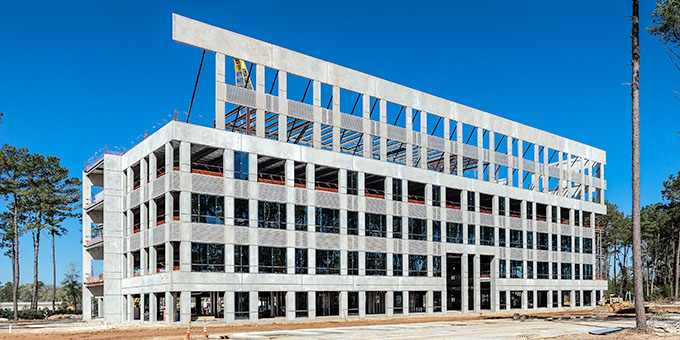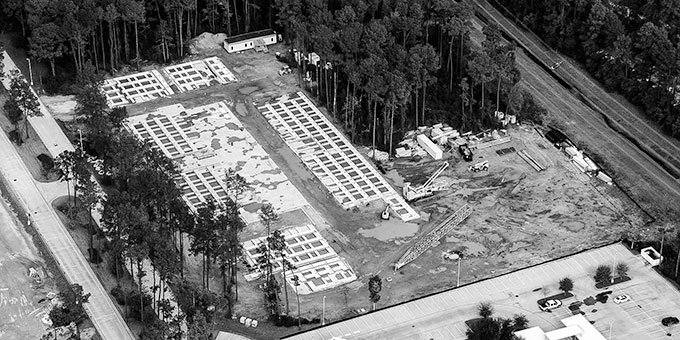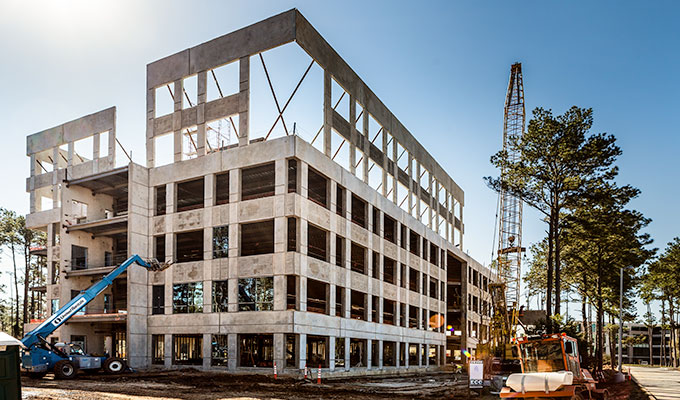SIERRA PINES II, A SIX-STORY CLASS A TILT-UP OFFICE BUILDING IS THE FIRST OF ITS KIND IN TEXAS. THE PROJECT IS SITUATED ON A SNUG 4-ACRE SITE LOCATED IN THE WOODLANDS, A 28,000-ACRE COMMUNITY IN SUBURBAN HOUSTON, TEXAS.
By: Mitch Bloomquist | Tilt-Up Concrete Association
CLASS A TILT?
Contrary to a once popular belief, class A tilt is not an oxymoron. Architects, engineers, contractors and developers aware of the architectural potential of tilt-up concrete construction have demonstrated time after time the superb quality that can be expected of the construction method.
According to CoStar Group, the world leader for commercial real estate intelligence, “a class A building is an extremely desirable investment-grade property with the highest quality construction and workmanship, materials and systems, significant architectural features, the highest quality/expensive finish and trim, abundant amenities, first rate maintenance and management; usually occupied by prestigious tenants with above average rental rates and in an excellent location with exceptional accessibility.” While these criteria offer a general picture of a class A facility, the label is somewhat subjective and most definitely relative to the market it is in. An excellent location in Houston, for example, may not fit the same criteria as an excellent location in New York City. Essential amenities in one market may not be as important in another. In Houston, every class A facility offers structured parking, for example. As Paul Coonrod, Managing Director of Stream Realty’s Houston office team and Partner in the firm’s Houston office put it, “Houston gets hot!” The intricacies of each market affect these ratings. “Even every submarket is different,” said Coonrod. “Houston, for instance, is divided into nine major submarkets.”
To hone in even further, Stream Realty breaks down class A into tiers. Class A1 according to Coonrod is the glass highrise with a prominent address. The top tier building is relatively new and boasts the very highest finishes, grand lobbies and exclusive amenities. The second tier, class A2, is where Sierra Pines II, the subject of this article, is categorized. Buildings in this category are at least three stories tall with high glass to wall ratios, very high quality finishes and excellent locations that are highly accessible and visible. Class A3 represents the older class A buildings, the great project on a not as great property, and the projects with slightly fewer amenities. “Fifty percent of class A office buildings built between 1976 and 1984 are most likely no longer considered class A,” said Coonrod. “Some projects though, no matter their age, will remain at the top as long as they are well maintained. These are the architectural icons located on the most prestigious properties.”
The architectural design of the project absolutely has an impact on the rates a property can command as a class A facility. In contrast, a class B office, as defined by CoStar Group, offers more utilitarian space without special attractions and will typically have ordinary architectural design.
“Stream Realty made it clear to us that they were looking for a top of the line project,” said Nazir Khalfe, RIBA, Powers Brown Architecture. “They wanted to be sure it had all of the grandeur of a class A building.”
The impressive features start with the site design. “The setting is remarkable,” notes Khalfe. The project is set back into a dense forest of trees and is surrounded by extensive landscaping. The sense of scale created by the tight setting is almost urban.
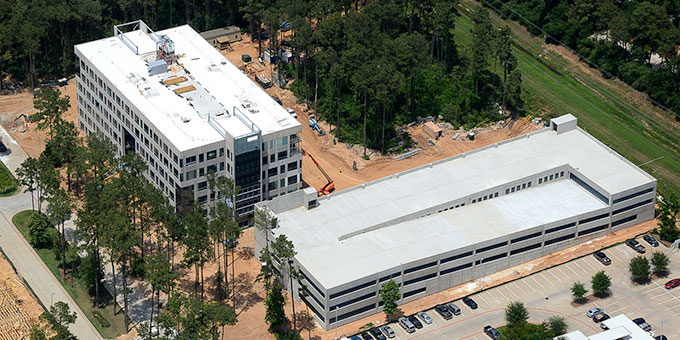
The building itself is very vertical in its proportions, which is uncharacteristic of many tilt-up projects. The verticality is accentuated by a series of slender vertical sunshade elements. While the building incorporates a great deal of glazing, openings are interrupted frequently by vertical elements keeping their proportions lean and denying any reading of the conventional ribbon window. Varying colors of glass help to break up larger openings and also contribute to the movement expressed on the façade.
Horizontality of another scale is denied at the center of the building where a four-story tall section of structural glazing marks the entrance. Visitors are welcomed into a grand two-story lobby sporting clean lines and dressed to the nines in high-end finishes. “We were able to reinvest some of the savings realized by utilizing tilt-up construction back into project,” said Coonrod. “The level of finish we were able to achieve is thanks in part to these efficiencies.”
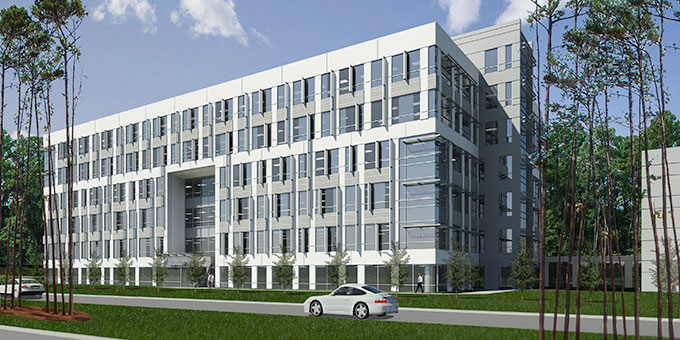
Sierra Pines II is only the second tilt-up project developed by Stream Realty in Houston and is Phase 2 of The Reserve at Sierra Pines. Powers Brown Architecture designed both projects. Phase 1, a three-story 175,000-sq. ft. project won a Tilt-Up Achievement Award from the TCA in 2011.
By all accounts, Phase 1 was a very successful project and investment. “We received a lot of great feedback on the first project,” said Coonrod. “The confidence gained from Phase 1 allowed us to push the envelope on the heels of its success.” Khalfe suggested the confidence of their client, Stream Realty, comes from knowledge of the tilt-up construction method, trust in the execution, first-hand experience of the savings and a sophisticated understanding of the market.
Coonrod noted that many investors and developers continue to build large footprint office buildings, and for Stream Realty, that makes sense in the Energy Corridor of Houston where large energy companies gobble up floors at a time. But again, every submarket is different. In The Woodlands, where Sierra Pines II is located, those 40,000 sq. ft. floor plates are not as attractive to smaller tenants. As the floor plate increases in size, the distance from the core to the face of the building increases as well. For smaller tenants, this means narrower spaces with less access to light and views. The 25,000 sq. ft. floor plates of Sierra Pines II make more sense for The Woodlands. Rising property values also play into this equation.
Naturally, as the cost of land increases, building higher makes more and more sense. “Rental rates increase with land value as well,” explained Coonrod. “However, the increase in rates does not often support a cast-in-place concrete or even steel tower.” The ability to build multistory or even midrise structures while realizing the savings afforded by tilt-up concrete construction presents a great opportunity.
FOUR + TWO
Site-cast tilt-up concrete panels do not have to fit on a truck. Their height is not restricted by the need to transport the panels down streets, around corners and over bridges. Their size can be limited, though, by bracing technology and crane availability. However, in the case of Sierra Pines II, the site ruled.
Founded in 1974, The Woodlands is one of America’s first master-planned communities. With a strong focus on environmental responsibility, the community prides itself on its over 7,000 acres of protected green space featuring trails, parks, and towering trees. Protecting those trees during the construction process was of great importance to the team. Efforts to do so made an already congested site even tighter.
The six-story walls are composed of a lower four-story panel with a two-story panel set on top. The four-story panels are 58ft-11in tall while upper two-story panels measure 31ft-2in in height. According to Jeff Griffin, Ph.D., P.E., PMP, Senior Project Manager at LJB Inc., there were no specific engineering reasons for breaking the panels into two. The over 90ft elevation could have been engineered as a single panel. But what can be done from an engineering standpoint may not be the best solution for construction, Griffin noted. Many times crane availability or bracing technology can lead a team to utilize stacked panels. However, in this instance, site constraints, namely casting area, restricted the height of the panels.
Stack casting panels is one option many contractors use when casting space is limited. Though, for Brad Mitchell, Superintendent for E.E. Reed Construction, that option would have slowed the process down too much. “We utilized every inch of space we could, and it wasn’t a lot!”
The four-story panels were cast on the building slab and adjacent casting beds, some of which were tucked snugly between soaring pine trees. Once they were lifted into place, the two-story panels were cast. While two different casting sequences is not as efficient as one, dividing the wall panels into two sections did present some advantages.
The first and most obvious advantage is that they were able to construct a relatively slender six-story building utilizing tilt-up construction on a very tight site. A second advantage is that the thickness of the two-story panels could be reduced. The lower four-story panels are 14in thick while the upper two-story panels are only 7 ½in thick.
Yet another advantage, having a dramatic effect on the rhythm of the façade, is the ability to shift the panel joints so that they are not aligned vertically from the top of the building to the bottom [Figure 1]. The pattern of openings shifts at the top two levels as well, breaking down further the scale of the building by denying the continuation of elements from top to bottom while maintaining a sense of verticality.
The shift in the pattern is not simply architectural; it has structural implications as well. The load path is disrupted at the shift creating highly concentrated loads over openings in the lower four-story panel. The wall, sixth floor and roof loads are transferred along fourth-story headers to the vertical legs of the lower panels.

As mentioned before, there is a deliberate departure from the ribbon window that traditionally dominates midrise office architecture. Ironically, it is the ribbon window that many tilt-up projects attempt to emulate in an effort to look more like conventional office construction, diverging from the panelized, punched opening language of industrial tilt-up.
Sierra Pines II takes a different approach. By separating the panel legs with openings instead of having them side by side [Figure 2] the legs appear much thinner and lighter. The panel joint itself is broken by the openings at each level, further deconstructing the perception of a large panel. The panel is broken down further through the application of contrasting finishes. In this case, Powers Brown Architecture has taken control of the visual weight and direction implied by the panels instead of allowing it to dictate.
![[Figure-2]](http://tilt-up.org/tilt-uptoday/wp-content/uploads/2014/07/Figure-2.jpg)
IN TEXAS, THEY CALL IT TILT-WALL
Recently, the New York Times published data gathered from 350,000 survey responses to a quiz titled “How Y’all, Youse and You Guys Talk.” The questions used in the quiz were based on the Harvard Dialect Survey, a linguistics project begun in 2002 by Bert Vaux and Scott Golder. The playful quiz offers insight into how the way we talk says a lot about where you’re from.
Construction is very much like a language. Just as each region has its own dialect, various regions approach tilt-up construction differently. Sometimes this is due to environmental conditions or code restrictions, and sometimes, as Mitchell understands, it is simply the result of how the trade or craft was passed down through the generations. “I’m a fifth generation concrete contractor,” said Mitchell. “I was lifting panels when I was thirteen!”
While some intricacies of execution are endearing and add to the culture of a given construction community, it is important to be open-minded to new ways of thinking. One of the roles the Tilt-Up Concrete Association plays in the industry is to ensure that efficiencies developed or discovered on the West Coast, for example, are communicated with those working in the South and vice versa. At the same time, one can learn of a mistake made in the Midwest and avoid repeating the error in the Northeast.
Dave Fillinger, Accubrace Program Manager for Dayton Superior joined the project team relatively late in the process. “It was during the TCA Convention in Houston that I met the team from E.E. Reed,” said Fillinger who works out of Ohio. “We got to talking, pulled up the drawings, and discovered the potential to eliminate 33 percent of the braces on the project.”
Because of the 4+2 stacking design and the configuration of the lower four-story panels with voluminous openings, the project was originally engineered to utilize three 52-ft tall braces per lower panel. By switching to higher-strength braces, it was possible to eliminate one brace per panel, or 33 percent of the braces.
“This is nothing new,” said Fillinger. “It’s just a matter of getting the information to the right people. The Blue Cross Blue Shield project in Miami, Florida was a 3+1 tilt that was designed and erected in 1995.” Once made aware of the potential, the team was quick to begin counting the savings. The switch meant 33 percent fewer brace-to-wall connections in the panels, 33 percent fewer helical anchors in the ground, less labor, lower rental costs and less crane time.
High-strength braces, however, do not always make sense. They are much heavier and therefore difficult to move around. They are also more expensive and, because the TCA Guideline for Temporary Wind Bracing of Tilt-Up Concrete Panels During Construction calls for a minimum of two braces per panel, their higher safe working load can be overkill on smaller panels. In this case though, they were a valuable resource.
In addition to reducing the number of braces per panel, the team was able to reduce the length of the braces as well from 52 ft to 42 ft. Because of the three-brace configuration and the location of openings in the panels, the taller braces were required to get above the openings. With only two braces per panel, they could be located between openings at a lower elevation. This presented additional savings on freighting. On a very tight site, this also meant some additional room around the perimeter as the shorter braces could be anchored closer to the structure.
Getting all of the underground utilities in place early was critical to the process. Because of the tight site, the vast majority of space surrounding the building would be occupied by casting slabs and braces. Both underground utilities and helical brace anchors had to be placed strategically to avoid conflicts. “Site logistics presented the biggest challenge on this project,” said Mitchell.
Due to soil conditions, it was necessary to take the foundation over 6ft below finished grade. To keep the panels from growing any taller, thereby saving casting space, a 5ft tall poured-in-place concrete stem wall extends from the top of the footing to 1ft below finished floor. A welded plate connection, similar to that used between the lower and upper panels, connects the four-story panel to the concrete stem wall.
“We approached the project like a highrise,” said Mitchell. The project was divided in two along its long (east/west) axis for the purposes of construction sequencing. As soon as possible, concrete was placed for the south half of floors 2-5. This allowed for the removal of the braces along the south of the building, which relieved site congestion.
At that point, crews were able to begin framing and worked to rough-in the vast majority of the mechanical, electrical and plumbing on the south side while work on the steel wrapped up on the north side of the structure. “We had plumbing rough-in complete up to level five before we started lifting the upper panels,” said Mitchell. The internal steel structure for floors 5 and 6 were also in place before the upper panels were lifted into place.
For a variety of reasons, welded plate panel-to-panel connections are utilized throughout the structure. At many instances, panel joints occur above openings creating cantilevers. The most dramatic conditions occur at the ends of the building where multistory openings wrap the corners of the building. The cantilevered header elements form a mitered corner condition. The panels are connected at the corner to stabilize the somewhat delicate arms of the panel and on the other side of the panel to reduce overturning forces in the plane of the wall created by the cantilever.
The building is designed to withstand 110 mph three-second wind gusts. These loads are greater than most inland locations, but typical for the region. This, too, contributes to the need to connect panels to one another.
Tilt-up panels, because of their width often take care of any shear forces acting on a building. However, because of the wind loads, an architectural mechanical screen on the roof, numerous large openings and the slender aspect ration of the building, diagonal bracing is installed at two interior column lines to supplement the concrete tilt-up panel shear walls.
“The main entrance panel [Figure 3] presented several engineering challenges,” said Griffin. The upturned “U” shaped panel is 58ft-11in tall and almost 40-feet wide with a four-story tall (54ft-11in) 30ft-wide opening. On the outside edges of the panel small, cantilevered fingers extend out to form half of the adjacent panels openings at each floor. The 14in-thick panel is designed with integral 16in returns along the large center opening for added rigidity. According to the team, this panel was the most difficult to tilt, while everything else was business as usual.

“Everything about this project was smooth,” said Freddy Maze with Big 4 Erectors. “We were able to run a small crew of six plus our foreman.” Big 4 utilized a 250-ton crawler with 210ft main boom to lift the panels. The four-story panels were eight-point picks and again were nothing out of the ordinary for Big 4. The upper panels were lifted in two steps. First, the two-story panels were stood in place and braced three or four at a time to minimize rigging changes. Next, the rigging was adjusted and the panels were picked from the top and lifted in to place. This was done so that the panels would hang vertically while being lifted into position. Crewmembers in 32-ft electric scissor lifts positioned on the fifth floor removed the rigging once connections were made and the braces were installed.
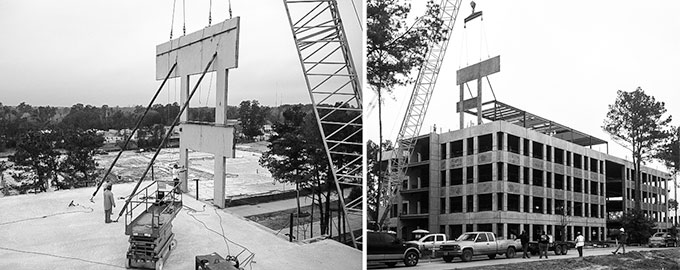
One would think setting a 30ft-tall panel on top of an almost 60ft-tall panel would be fairly complicated and nerve-wracking as well, but according to Mitchell the process was flawless. The outside faces of the panels are aligned and there is a welded plate connection between the lower and upper panels. “The engineer designed it beautifully,” said Mitchell. “The connection was very easy to make and having the panels welded right away was very convenient.” Tim Manherz, Operations Manager for TAS Commercial Concrete echoed Mitchell’s sentiment and noted that the architectural design also simplified what could have been a very difficult connection. “Aligning the panels was very easy,” said Manherz. “Because of the shift in joint location at the upper panels, there was nothing we had to match up to exactly. This gave us some play and allowed the process to go very quickly.”
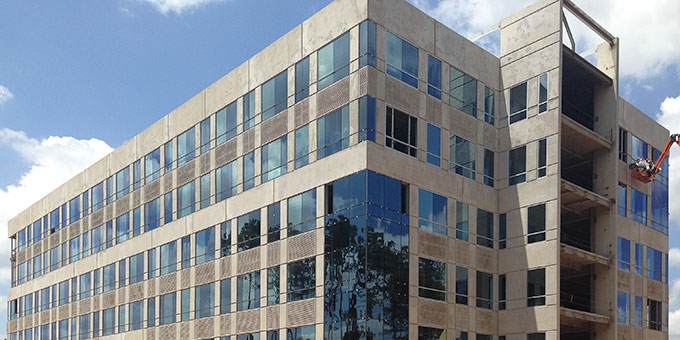
The glazing system was installed right along with everything else in a quick and efficient sequence. All of the glass for floors one through three was installed prior to tying the upper panels back to the structure. To keep the glass from being damaged by welding activity on the upper levels, the fourth-story glass had to wait, but the glazing crew was not far behind. As soon as the connections were made on one panel, the glass was installed. “Everyone’s chasing everyone,” explained Mitchell. “Yet no one is in a rush.”
“Safety is the first priority, and quality is next,” said Mitchell. The need for speed is great, but not at the expense of quality. “What you can see and touch sells jobs,” said Mitchell. “We know what our client expects.”
Staying on schedule ensures that at each phase and each element the proper amount of time can be spent getting it right. Working ahead of schedule, gaining as much time as possible, accounts for the unknowns. “There are bones in every project,” said Mitchell referring to the inevitable issues that arise on each job.
Construction started at the end of September 2013 and will wrap up in August 2014. Through March, the project had endured 30 rain days without missing a mark. “That tells you what kind of team we have out here,” said Mitchell. “We know what needs to be done and sometimes that means working over the weekend.” Mitchell reiterated though that the level of intensity requires extra attention to safety.
Safety meetings are held on site every Friday morning. According to Mitchell, crews are sharp and energetic early in the week. Towards the weekend, people start to get tired and that’s when mistakes and accidents happen. “I give them a little pep talk on Friday mornings,” said Mitchell. “At the end of the day, everyone needs to be able to get home to their family. That’s why we go to work.”
WHAT’S NEXT?
Besides hospitals, which usually top out around six-stories and perhaps multi-family housing or hotels, the office building is the most likely to command a structure taller than six stories that could potentially be executed in tilt-up.
Office projects over six stories, however, are not economical for developers until they reach ten or more stories according to Jeffrey Brown, AIA of Powers Brown Architecture. “Not much wants to be seven to ten stories,” said Brown. “Projects over six stories must carry the added cost of a variety of high-rise code related issues.” The extra four or more stories help to dilute those cost implications.
Projects in the seven to ten story range are most likely build-to-suit projects which are less likely to be cost driven. Even at ten stories though, unless significant cost savings are there, conventional construction will be chosen over tilt-up due to its familiarity and perception of higher value.
“It’s important to get projects like this out there,” said Fillinger. “Stacking panels is a great solution in many instances. Getting contractors and owners comfortable with the concept will open up doors for the industry.”
“Minimizing the top stacked panel is important,” said Brown. With taller panels, the top level can quickly get crowded with braces. At the same time, the taller the bottom panels are, the more work can be done while casting and erecting the upper panels. Other issues to consider and investigate are the various stacking combinations, 4+1, 4+2, 5+1, 5+2, 5+2+2 and so on. Additional questions arise such as, do you switch out cranes after lifting the heavy bottom panels? Is there a time when a tower crane would make sense? How could stack casting be utilized in an efficient manner?
The entire team communicated their interest in continuing to push the envelope and seemed to be aware of the collaboration necessary to keep the momentum going. “We are not in an economy or time where clients are going to pay much for research and development,” said Brown. “We have to have all of the answers before coming to the table.” Sharing experiences and lessons learned helps advance the industry by making better project teams. Better project teams build better tilt-up buildings and better tilt-up buildings sell more tilt-up buildings.
